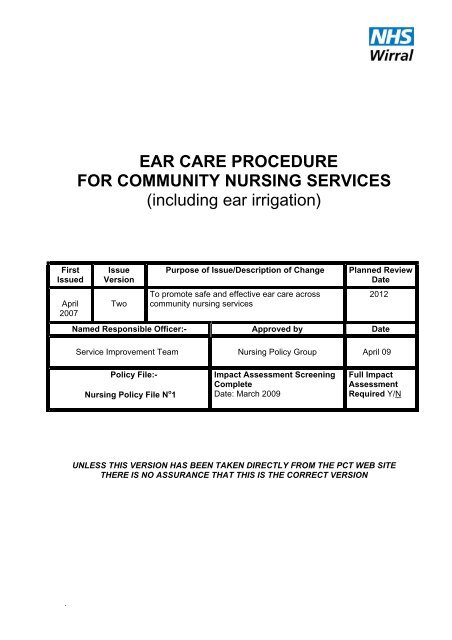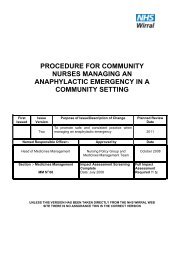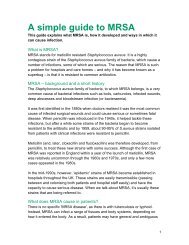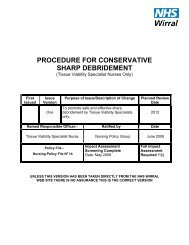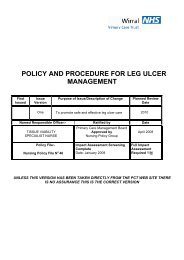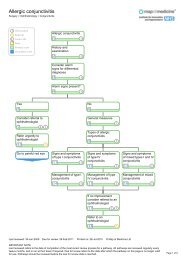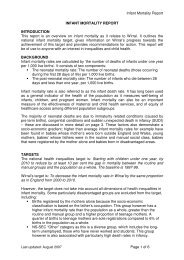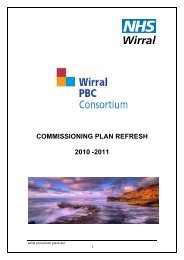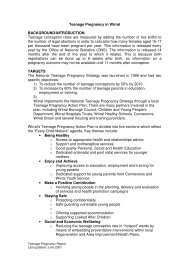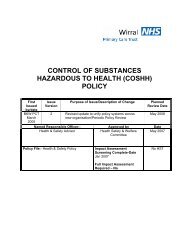EAR CARE PROCEDURE FOR COMMUNITY NURSING SERVICES
EAR CARE PROCEDURE FOR COMMUNITY NURSING SERVICES
EAR CARE PROCEDURE FOR COMMUNITY NURSING SERVICES
Create successful ePaper yourself
Turn your PDF publications into a flip-book with our unique Google optimized e-Paper software.
<strong>EAR</strong> <strong>CARE</strong> <strong>PROCEDURE</strong><br />
<strong>FOR</strong> <strong>COMMUNITY</strong> <strong>NURSING</strong> <strong>SERVICES</strong><br />
(including ear irrigation)<br />
First<br />
Issued<br />
April<br />
2007<br />
Issue<br />
Version<br />
Two<br />
Purpose of Issue/Description of Change<br />
To promote safe and effective ear care across<br />
community nursing services<br />
Planned Review<br />
Date<br />
2012<br />
Named Responsible Officer:- Approved by Date<br />
Service Improvement Team Nursing Policy Group April 09<br />
Policy File:-<br />
Nursing Policy File N o 1<br />
Impact Assessment Screening<br />
Complete<br />
Date: March 2009<br />
Full Impact<br />
Assessment<br />
Required Y/N<br />
UNLESS THIS VERSION HAS BEEN TAKEN DIRECTLY FROM THE PCT WEB SITE<br />
THERE IS NO ASSURANCE THAT THIS IS THE CORRECT VERSION<br />
.
<strong>EAR</strong> <strong>CARE</strong> <strong>PROCEDURE</strong> (including ear irrigation)<br />
INTRODUCTION<br />
Wax (cerumen) is a normal secretion of the ceruminous gland. A small amount of<br />
wax is normally found in the ear canal, and its absence may indicate that excessive<br />
cleaning, dry skin conditions or infection has interferred with the normal production<br />
of wax.<br />
It is only when there is an accumulation of wax that removal may become<br />
necessary. In order to ascertain whether removal by irrigation is necessary, a full<br />
assessment must be undertaked which includes examination of the ear with an<br />
auroscope. The ear care documentation below must be used to undertake<br />
assessment. Registered nurses who have undertaken PCT Ear Care training can<br />
undertake ear irrigation, using the pathway, without prior examination by a general<br />
practitioner.<br />
Community nursing teams will provide the service for housebound pateints.<br />
TARGET GROUP<br />
Ear care must only be undertaken by PCT employed Registered Nurses that have<br />
undergone appropriate Ear Care Training, provided by Rotherham Ear Care Centre.<br />
Assistance with the administration of ear drops may be delegated to Nursing<br />
Auxiliaries provided that the Registered Nurse provides detailed instructions and<br />
assesses the competence of the Nursing Auxiliary to perform the task and monitors<br />
progress.<br />
RELATED POLICIES<br />
• PCT Health Records Policy<br />
• NMC (2008) The NMC code of professional conduct: standards for<br />
conduct,performance and ethics.<br />
• PCT Record Keeping Procedure for Community Nursing<br />
• ICP4 Policy for the Decontamination of Re-usable Medical Devices<br />
• ICP5 Hand Decontamination<br />
• ICP10 Policy on the Use of Personal Protective Equipment<br />
• ICP14 Single Use Equipment Policy<br />
• ICP18 Clinical Waste Policy<br />
• Clinical Waste Policy<br />
• Incident Reporting Policy<br />
• Medical Devices Policy<br />
• Consent Policy<br />
NB Always use most current versions of PCT and NMC policies as may be<br />
superseded at any time.<br />
<strong>EAR</strong> <strong>CARE</strong> <strong>PROCEDURE</strong><br />
2/13
Documentation<br />
Nursing Management of Ear Wax – Documentation<br />
Propulse electronic ear syringe cleaning procedure<br />
<strong>PROCEDURE</strong> <strong>FOR</strong> <strong>EAR</strong> EXAMINATION<br />
<strong>PROCEDURE</strong><br />
Verbally check the identity of the patient by asking<br />
the patients full name and date of birth. Check<br />
with carer/family if not able to confirm identity<br />
Before careful physical examination of the ear,<br />
listen to the patient, elicit symptoms and take a<br />
history. Explain procedure and obtain informed<br />
consent<br />
Establish patient has no known allergies, check in<br />
patients records and also ask patient / family of<br />
any known history<br />
Decontaminate hands<br />
Examine pinna, outer meatus and adjacent scalp<br />
Choose appropriately sized speculum<br />
Pull the pinna upwards and outwards<br />
To confirm identity<br />
RATIONALE<br />
To allow the patient / client to make an<br />
informed decision and gain cooperation<br />
To reduce allergic reactions<br />
To prevent spread of micro-organisms<br />
Evidence of surgical intervention,<br />
infection, discharge, swelling and signs<br />
of skin lesions may be evident<br />
To prevent damage to the ear canal<br />
To straighten the ear canal<br />
If this is painful do not continue, as pain<br />
may indicate infection / inflammation<br />
Hold the otoscope like a pen and rest the small<br />
digit on the patient’s head as a trigger for any<br />
unexpected head movement<br />
Insert the speculum gently into the ear canal<br />
Attempt to view the tympanic membrane,<br />
observing for any abnormalities<br />
Check for presence of a mastoid cavity – if<br />
present, inspect all parts of the cavity and refer<br />
any concerns to General Practitioner. Mastoid<br />
cavities must not be irrigated<br />
Decontaminate hands<br />
Observe condition of skin when withdrawing<br />
otoscope and note the presence, amount and<br />
consistency of any wax present<br />
Document observations on ear care assessment<br />
form (Appendix 1)<br />
Dispose of single use speculum<br />
To undertake visual assessment and<br />
reduce the risk of trauma<br />
Irrigation should not be carried out if<br />
evidence of infection or perforation is<br />
noted<br />
Any intervention with mastoid cavities<br />
must only be undertaken by an ear care<br />
specialist<br />
To prevent spread of micro-organisms<br />
Subsequent advice and treatment is<br />
dependent on condition of wax present<br />
Ensure compliance with NMC and local<br />
record keeping guidelines<br />
To ensure speculum cannot be reused<br />
<strong>EAR</strong> <strong>CARE</strong> <strong>PROCEDURE</strong><br />
3/13
• If hard, impacted wax is identified, advise the use of olive oil drops for 5 days<br />
and reassess after this time (avoid extra virgin olive oil). Instill one to two<br />
drops, twice a day for five to seven days and then re-assess<br />
• If soft wax is present and risk assessment (Appendix 1) does not indicate<br />
any contraindications then ear / ears may be irrigated<br />
<strong>EAR</strong> IRRIGATION<br />
Ear irrigation must only be undertaken using the propulse electric ear irrigator<br />
provided by the PCT. Syringes must not be used to irrigate ears.<br />
Do not irrigate ear if any of the following contraindications are noted:<br />
• The patient has previously experienced complications following ear irrigation<br />
in the past<br />
• There is a history of middle ear infection in the past 6 weeks<br />
• The patient has undergone any ear surgery (excluding grommets that have<br />
extruded at least 18 months previously and the patient has been discharged<br />
from Ear, Nose and Throat services)<br />
• The patient has a perforation or there is a history of a mucous discharge in<br />
the last year<br />
• The patient has a cleft palate (whether repaired or not)<br />
• Acute otitis externa with pain and tenderness of the pinna is noted<br />
• Patient is currently taking anticoagulant therapy<br />
• A patient who has hearing only in one ear if it is the ear to be treated, as<br />
there is a remote chance that irrigation may cause permanent deafness<br />
• Acute undiagnosed hearing loss that is not related to the accumulation of ear<br />
wax<br />
• There is insufficient light<br />
Equipment Required<br />
• Otoscope<br />
• Speculae - single use items only after the 1 st April 2007<br />
Propulse electric irrigator and other equipment (cleaned in<br />
accordance with this policy – see page 12)<br />
• Propulse electronic ear syringe cleaning procedure<br />
• Jug<br />
• Bath thermometer<br />
• Trough / Receiver<br />
• Tissues<br />
• Clean towel<br />
• Protective clothing<br />
<strong>PROCEDURE</strong><br />
Verbally check the identity of the patient by<br />
asking for full mane and date of birth.<br />
Check with carer/family if not able to<br />
confirm identity<br />
To confirm identity<br />
RATIONALE<br />
<strong>EAR</strong> <strong>CARE</strong> <strong>PROCEDURE</strong><br />
4/13
<strong>PROCEDURE</strong><br />
Ask patient occupation or previous<br />
occupation/s<br />
Obtain valid and informed consent for<br />
procedure and document assessment<br />
using risk assessment form.<br />
Inform patient that there is slight risk that<br />
ear irrigation may cause infection, injury to<br />
the ear canal and perforation of the ear<br />
drum<br />
Decontaminate hands<br />
Put on protective clothing<br />
Ask patient to sit in chair with head tilted<br />
towards the ear that is to be syringed<br />
Place towel on patient’s shoulder and ask<br />
patient to hold receiver under same ear<br />
Fill the reservoir of the ear irrigator with<br />
water – water temperature must be<br />
checked and should be approximately<br />
40°C<br />
Set pressure of machine to minimum<br />
Attach new jet tip applicator to machine<br />
Run the machine for 10-20 seconds,<br />
directing the tip into the receiver.<br />
Inform patient that procedure is about to<br />
start and encourage patient to indicate if<br />
pain or dizziness is experienced<br />
Pull the pinna upwards and outwards and<br />
insert the tip of the nozzle into the ear<br />
canal<br />
Begin irrigating using the foot control to<br />
operate the machine – the nozzle should<br />
be directed so that the stream of water is<br />
directed along the roof of the ear canal<br />
towards the posterior canal wall at<br />
approximately a 30 o angle<br />
Increase pressure control gradually if wax<br />
is difficult to remove ( Do not use<br />
maximum)<br />
If patient complains of water in the back of<br />
their mouth, stop procedure and refer to<br />
GP<br />
RATIONALE<br />
Informs clinical decision making<br />
To allow the patient / client to make an<br />
informed decision<br />
To prevent spread of micro-organisms<br />
Protect from splashing and potential<br />
contamination during procedure<br />
To encourage water to flow back out of<br />
ear<br />
Collection of water and patient comfort<br />
Water above or below this temperature<br />
may cause discomfort and / or<br />
dizziness<br />
To reduce the potential for trauma<br />
Single use only jet tips<br />
Patient becomes accustomed to the<br />
noise of the machine<br />
Cold water and air locks are removed<br />
Procedure must be stopped if these<br />
symptoms are experienced<br />
Straightens the ear canal<br />
Directs flow of water to encourage best<br />
removal of wax<br />
To help remove wax<br />
Patient may have perforated ear drum<br />
<strong>EAR</strong> <strong>CARE</strong> <strong>PROCEDURE</strong><br />
5/13
<strong>PROCEDURE</strong><br />
Irrigation should never cause pain. if the<br />
patient complains of pain - stop<br />
immediately.<br />
Periodically inspect ear with otoscope<br />
during procedure and check irrigated water<br />
for presence of wax<br />
A maximum of one reservoir of water can<br />
be used per ear – stop irrigating after 5<br />
minutes<br />
Dry excess water from external meatus<br />
once irrigation is complete<br />
Re-examine the ear, observing for any<br />
abnormalities – refer to GP if necessary<br />
If wax is removed due to the presenting<br />
complaint of hearing loss, ascertain<br />
whether good hearing is restored after<br />
treatment – refer to GP if hearing is not<br />
restored<br />
Decontaminate hands<br />
Dispose of contents of trough / receiver<br />
and decontaminate equipment<br />
Document all observations and actions<br />
including consent and patient perceptions<br />
RATIONALE<br />
To prevent damage to ear<br />
To identify if irrigation is effective or<br />
complete<br />
Further irrigation is likely to be<br />
ineffective – patient may require a<br />
further course of drops.<br />
(Further irrigation may be attempted 15<br />
minutes after initial irrigation if<br />
appropriate)<br />
Stagnation of water and abrasion of<br />
skin predispose infection<br />
Irrigation can sometimes cause trauma<br />
Wax may hide evidence of<br />
abnormalities<br />
To ensure assessment of cause of<br />
hearing loss and possible referral to an<br />
ENT surgeon or Audiologist.<br />
To prevent spread of micro-organisms<br />
To prevent spread of micro-organisms<br />
Ensure compliance with NMC and local<br />
record keeping guidelines<br />
Provide post-procedure ear care<br />
information leaflet<br />
Ensure patient remains informed and<br />
involved with their care<br />
The information above is adapted from guidance devised by the ‘Action on ENT’<br />
steering board and is endorsed by the Primary Care Ear Centre – Rotherham.<br />
www.earcarecentre.com<br />
<strong>EAR</strong> <strong>CARE</strong> <strong>PROCEDURE</strong><br />
6/13
<strong>NURSING</strong> MANAGEMENT OF <strong>EAR</strong> WAX – DOCUMENTATION<br />
(1/4 pages)<br />
(For patients over 18 years)<br />
Prior to undertaking ear examination the nurse should have a<br />
demonstrable knowledge of the tympanic membrane and auditory canal<br />
and should have attended appropriate training in ear care. Valid<br />
consent to any treatment must be obtained and documented.<br />
Patient Details:<br />
NHS No:<br />
Full Name<br />
Address<br />
Telephone Number:<br />
Date of Assessment:<br />
DOB:<br />
Referred by:<br />
Current & Previous Occupation:<br />
GP:<br />
Current Medication:<br />
Informed Consent ____________________________________________________<br />
Each nurse must be confident they have the clinical competency and the<br />
underpinning knowledge to fulfil this role. Best practice would be for each nurse<br />
that undertakes this role to consider the disease processes that may require caution<br />
and the need for additional information about the patient and their treatment. This<br />
may include:-<br />
MEDICATION<br />
Diuretic Therapy<br />
Anticoagulant Therapy<br />
Long-term use of ototoxic drugs e.g.<br />
streptomycin<br />
RATIONALE<br />
May lead to hearing loss<br />
trauma<br />
hearing loss<br />
<strong>EAR</strong> <strong>CARE</strong> <strong>PROCEDURE</strong><br />
7/13
AURAL <strong>NURSING</strong> RISK ASSESSMENT RECORD<br />
Patients Full Name:<br />
DOB:<br />
NHS Number:-<br />
Left Ear Right Ear<br />
YES NO YES NO<br />
History of tympanic perforation<br />
Cleft Palate<br />
Unable to give valid consent<br />
Recent history of otalgia (ear ache) or<br />
middle ear infection [in previous six weeks]<br />
Does the patient have history of hearing loss that<br />
is not related to the excess production of wax<br />
Does the patient have hearing in only one ear <br />
[NB such patients should not have that ear<br />
irrigated as the risk of damage (although minimal)<br />
is unacceptable - refer to GP]<br />
Have there been any significant problems<br />
previously with ear irrigation e.g pain /<br />
perforation / vertigo after procedure / other <br />
Please state:<br />
Mucoid / discharge other than waxy discharge<br />
Is there a recent history of Giddiness, nausea,<br />
vertigo or Ear surgery e.g. mastoid<br />
NB NEVER IRRIGATE A MASTOID CAVITY<br />
Tinnitus or menieres disease<br />
Is patient currently taking anticoagulants<br />
CLINICAL ASSESSMENT<br />
Check for signs for foreign bodies e.g. grommets,<br />
inflammation / discharge, offensive discharge<br />
Otitis media / externa (usually found in both ears)<br />
Left Ear Right Ear<br />
Yes No Yes No<br />
Pain in or about ear when moving pinna Please<br />
state:<br />
Swelling in or around the ear<br />
Evidence of impacted wax<br />
Hearing Aid<br />
Non concordance to treatment /no valid consent<br />
DO NOT IRRIGATE <strong>EAR</strong>/S IF THE ANSWER IS YES TO ANY OF THE ABOVE –<br />
REFER PATIENT TO MEDICAL PRACTITIONER<br />
<strong>EAR</strong> <strong>CARE</strong> <strong>PROCEDURE</strong><br />
8/13
Patients Full Name:<br />
NHS Number:-<br />
DOB:<br />
Patient referred to:<br />
Date:<br />
Have Olive oil drops been instilled as<br />
recommended (minimum of 5 days)<br />
Left Ear<br />
Right Ear<br />
Yes No Yes No<br />
If the patient has not undertaken appropriate<br />
preparation then give advice and rebook<br />
appointment for one week<br />
Outcome<br />
If following the assessment there are no identified problems and there is evidence<br />
of wax, then proceed with the ear irrigation in accordance with Trust guidance. If<br />
there are problems, refer to GP.<br />
The recommendation for the use of olive oil ear drops is that some patients may<br />
have a nut allergy. Also, some proprietary preparations containing organic solvents<br />
can cause irritation of the meatal skin. (extract from the BNF 12.1.3) (NPF 1999-<br />
2001)<br />
<strong>EAR</strong> <strong>CARE</strong> <strong>PROCEDURE</strong><br />
9/13
Patients Full Name:<br />
NHS Number:-<br />
<strong>EAR</strong> IRRIGATED<br />
DOB:<br />
Left Ear<br />
Right Ear<br />
Yes No Yes No<br />
Was wax successfully removed<br />
Advice given:<br />
Details<br />
Is review of treatment requested:<br />
Yes/No<br />
Date of<br />
review:<br />
Yes<br />
No<br />
Leaflet given to patient following procedure and<br />
contents discussed<br />
Understanding checked<br />
Nurse's Name<br />
Signature Designation :-<br />
Contact Number<br />
The information above is adapted from guidance devised by the ‘Action<br />
on ENT’ steering board and is endorsed by the Primary Care Ear<br />
Centre – Rotherham. (See www.earcarecentre.com)<br />
<strong>EAR</strong> <strong>CARE</strong> <strong>PROCEDURE</strong><br />
10/13
<strong>EAR</strong> IRRIGATION PATHWAY <strong>FOR</strong> <strong>COMMUNITY</strong> NURSES<br />
All patients must have applied 5 days of ear drops to soften wax<br />
(This can be prescribed by a GP or Nurse Prescriber)<br />
Ears examined and Nursing Aural Risk Assessment completed<br />
Outcome of assessment<br />
Soft wax present<br />
and no risk factors<br />
identified<br />
Wax has been<br />
cleared by the<br />
drops<br />
Hard,<br />
impacted wax<br />
present<br />
Risk factors<br />
identified<br />
Proceed to carry<br />
out ear irrigation<br />
If patient<br />
continues to<br />
experience<br />
hearing loss<br />
advise to see<br />
GP<br />
Advise to<br />
continue with<br />
drops for a<br />
further 5<br />
days<br />
Investigate<br />
compliance<br />
issues<br />
Do not<br />
irrigate ears<br />
Refer to GP<br />
May need ENT<br />
/ Audiology<br />
referral<br />
Re-book<br />
appointment<br />
NB In cases where a patient cannot give informed consent or provide a history to<br />
complete aural risk assessment and discuss with the GP<br />
<strong>EAR</strong> <strong>CARE</strong> <strong>PROCEDURE</strong><br />
11/13
PROPULSE ELECTRONIC <strong>EAR</strong> SYRINGE<br />
CLEANING <strong>PROCEDURE</strong><br />
It is important that this equipment is decontaminated at the end of a session or at the end of<br />
each day and before use to prevent cross infection between patients or cross infection from<br />
inadequately disinfected equipment.<br />
Jet tips are single use only items.<br />
HEALTH AND SAFETY IN<strong>FOR</strong>MATION<br />
Before using any cleaning/disinfection product staff must satisfy themselves that<br />
they are aware of safe handling, storage and dilution strengths of the product used.<br />
COSHH data must be read and available to all staff.<br />
CLEANING AGENTS/DISINFECTANTS REQUIRED<br />
General Purpose Detergent<br />
NADCC disinfectant tablets (Antichlor 0.5g)<br />
Dilution strength: 1,000 parts per million<br />
Dissolve 2 x 0.5g tablets in ½ litre of cold water<br />
DISINFECTANT IN<strong>FOR</strong>MATION<br />
NADCC is a broad spectrum anti-microbial agent which is effective against bacteria, fungi<br />
and viruses (including HIV, Hepatitis, MRSA, E.coli and pseudomonas). It is more stable<br />
and therefore more effective than liquid forms of sodium hypochlorite. Tablets have a<br />
longer shelf life and are more convenient to use and correctly prepared give an accurate<br />
strength. NADCC is an approved disinfectant in the Trust Disinfection Policy<br />
DECONTAMINATING THE MACHINE BE<strong>FOR</strong>E USE (This need only be once a day)<br />
1. Fill the tank ¾ full with the freshly prepared NADCC solution.<br />
2. Run the machine for a few seconds into a sink to ensure all the internal pipe work is<br />
filled with the solution.<br />
3. Stop the machine, leave to stand for 10 minutes to disinfect.<br />
4. After 10 minutes empty the tank and refill with fresh tap water.<br />
5. Run this through the machine to thoroughly rinse the system.<br />
6. Discard any remaining NADCC solution, rinse and dry jug.<br />
The machine is now ready for use<br />
Note:<br />
It is not advisable to attempt decontamination within a patient’s home.<br />
<strong>EAR</strong> <strong>CARE</strong> <strong>PROCEDURE</strong><br />
12/13
DECONTAMINATING THE MACHINE AT THE END OF THE DAY/CLINIC SESSION<br />
1. Prepare a detergent solution in the Propulse tank, run the machine into a sink for a<br />
few minutes to flush pipe work and pump.<br />
2. Discard remaining solution, rinse tank with fresh tap water.<br />
3. Fill tank ¾ full with a freshly prepared solution of 1,000ppm NADCC disinfectant.<br />
4. Run solution through the machine into the sink to fill internal pipe work and pump.<br />
5. Leave for 10 minutes to disinfect.<br />
6. Empty tank and refill with fresh tap water.<br />
7. Run machine for a few minutes into a sink to rinse internal pipe work.<br />
8. Empty tank, rinse and dry with disposable paper towel.<br />
9. Damp clean the exterior of the machine within a disposable cloth soaked in a detergent<br />
solution.<br />
10. Discard any remaining NADCC solution, rinse and dry jug.<br />
11. Store the machine and tips in a dust free environment.<br />
INFECTION CONTROL ADVICE:<br />
This guidance has been based on informed infection control principles until more detailed<br />
information is available from the manufacturer.<br />
References<br />
The Primary Ear Care Centre, Rotherham (2006)<br />
<strong>EAR</strong> <strong>CARE</strong> <strong>PROCEDURE</strong><br />
13/13


